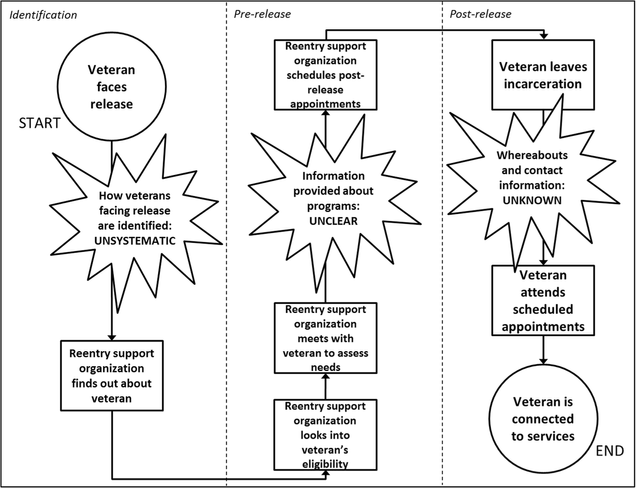Formerly Incarcerated Veterans Face Gaps in Connecting with Services.
 Between 12,000 and 16,000 veterans leave incarceration every year. The Department of Veterans Affairs (VA) Health Care for Reentry Veterans program links recently-released veterans to VA and community healthcare services. But many of these veterans fall through the cracks or are unable to get longterm support—putting them at high risk of homelessness, substance use disorder relapse, worsened mental health, and recidivism.
Between 12,000 and 16,000 veterans leave incarceration every year. The Department of Veterans Affairs (VA) Health Care for Reentry Veterans program links recently-released veterans to VA and community healthcare services. But many of these veterans fall through the cracks or are unable to get longterm support—putting them at high risk of homelessness, substance use disorder relapse, worsened mental health, and recidivism.
A new study, co-authored by School of Public Health researchers, identifies some of the gaps in the process of connecting recently released veterans with these services in Massachusetts. It finds that reentry programs lack systematic means of identifying incarcerated veterans ahead of release and staying connected with them afterwards, while veterans themselves lack information about these support services.
Published in the journal Health & Justice, the study is a formative part of the Post-Incarceration Engagement (PIE) project. Led by SPH researchers at the VA Center for Healthcare Organization and Implementation Research (CHOIR), Bedford/Boston, the project is developing a peer-support system to help veterans transition out of incarceration.

“It is surprising that what seems like a clear and easy-to-follow, step-by-step process would still be filled with uncertainties and idiosyncrasies that require alert and dedicated staff in a variety of organizations to pick up the ball to avoid persons falling through the cracks,” says study senior author D. Keith McInnes, research associate professor of health law, policy & management at SPH and a CHOIR investigator. McInnes is co-principal investigator on the PIE project.
For the new study, the researchers gathered information from qualitative interviews with representatives of reentry support organizations, then used the information from these interviews to systematically generate process maps. Process mapping is a visualization technique often used in quality improvement to illustrate complex processes and identify gaps in services and linkages. Healthcare researchers have recently begun using the strategy as well, but this is the first time that researchers have applied process mapping to the transition from incarceration to reentry services.
“Process mapping is specifically meant to help identify uncertainties, gaps, bottlenecks, and inefficiencies in a process,” says study lead author Bo Kim, a CHOIR investigator and an instructor at Harvard Medical School. “This is especially valuable when the process involves multiple stakeholder, where no single stakeholder is knowledgeable about all the key steps that constitute the process.”

Using process mapping, the researchers found significant variation in how and what information is made available to veterans as they go through release and reentry planning, and that support organizations do not know what information veterans have already received prior to release. They also found that organizations had trouble maintaining contact with released veterans after their release, with interviewees emphasizing the need to be able to provide support immediately after release.
McInnes says Massachusetts has a large number of organizations assisting veterans and others coming out of incarceration, “but maybe for that very reason, and because they represent different organizational cultures and systems, creating a systematic process that works for 95 percent or more of cases has been so hard to develop.”
The researchers also concluded that process mapping was itself an effective tool for studying this issue, and could be useful for other researchers and stakeholders trying to understand and improve health care and other systems for justice-involved populations.
The study was co-authored by Megan McCullough, research assistant professor of health law, policy & management; Mari-Lynn Drainoni, associate professor of health law, policy & management; B. Graeme Fincke, associate professor of health law, policy & management; and Justeen Hyde of the School of Medicine. The other co-authors were Molly Simmons of the RAND Corporation and Rendelle Bolton of CHOIR and Brandeis University.